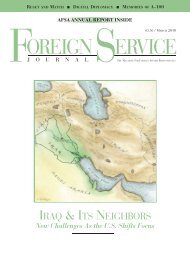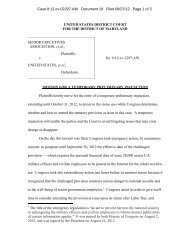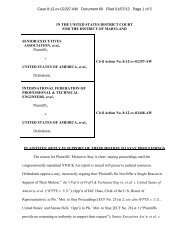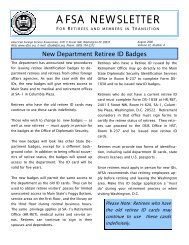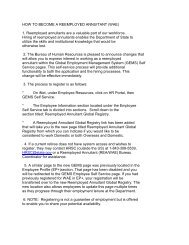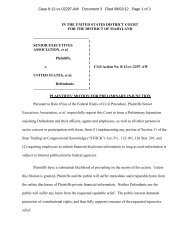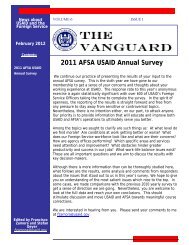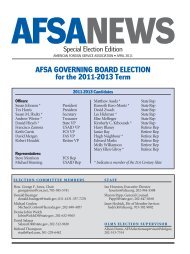F OCUS - American Foreign Service Association
F OCUS - American Foreign Service Association
F OCUS - American Foreign Service Association
Create successful ePaper yourself
Turn your PDF publications into a flip-book with our unique Google optimized e-Paper software.
Into the Breach?<br />
NATO’s involvement in Afghanistan<br />
was not something explicitly<br />
mandated by the Bonn Agreement<br />
of December 2001 that sketched a<br />
pathway for Afghanistan’s “post-conflict”<br />
transition. But it was naturally<br />
assumed that the organization would<br />
be involved, not least because of the<br />
solidarity with the United States that<br />
NATO and its members had voiced<br />
after the 9/11 attacks.<br />
In Annex I to the Bonn Agreement,<br />
the participants sought the “assistance of the international<br />
community in helping the new Afghan authorities<br />
in the establishment and training of new Afghan<br />
security and armed forces.” They further requested the<br />
United Nations Security Council “to consider authorizing<br />
the early deployment to Afghanistan of a United<br />
Nations–mandated force” to “assist in the maintenance of<br />
security for Kabul and its surrounding area.” Such a<br />
force “could, as appropriate, be progressively expanded<br />
to other urban centers and other areas.” The Security<br />
Council proceeded, through Resolution 1386 adopted on<br />
Dec. 20, 2001, to authorize the establishment of an<br />
International Security Assistance Force, with a “Chapter<br />
VII” enforcement mandate to take action “to maintain or<br />
restore international peace and security.”<br />
Ideally, this force should have been deployed throughout<br />
the country as rapidly as possible, to consolidate the<br />
momentum that the overthrow of the Taliban regime had<br />
created. But this was not to be. Differences emerged<br />
between the NATO allies over the burdens to be carried.<br />
And the Bush administration — perhaps with an eye to<br />
future operations in Iraq — was reluctant to commit the<br />
airlift capability required to sustain an expanded ISAF.<br />
This came to a head in a very public way, through the<br />
publication in the Washington Post on March 20, 2002, of<br />
an article headlined “Peacekeepers Won’t Go Beyond<br />
Kabul, Cheney Says.”<br />
This effectively killed off the idea of ISAF expansion<br />
in the short run, although alarmed observers continued<br />
to press for it to happen. Not until Oct. 13, 2003, with<br />
Security Council Resolution 1510, did the ISAF receive<br />
a wider mandate — two months after NATO had formally<br />
assumed authority for the ISAF mission. (The shift to<br />
NATO leadership was designed to overcome the disloca-<br />
F <strong>OCUS</strong><br />
The Afghanistan theater<br />
of operations is proving<br />
to be a critical test of<br />
NATO’s capacities in<br />
the post–Cold War<br />
world.<br />
tions that had earlier arisen as new<br />
states were inducted to lead the mission<br />
for six-month periods.) By then,<br />
however, critical time had been lost.<br />
The need to find an on-theground<br />
substitute for an expanded<br />
ISAF was a key factor contributing<br />
to the development of the Provincial<br />
Reconstruction Team model, which<br />
also drew on some of the experiences<br />
of the U.S. military in South<br />
Vietnam — the Civil Operations and<br />
Revolutionary Development Support<br />
program, in particular.<br />
The model envisaged cooperative endeavors by military<br />
and civilian affairs personnel in support of the reconstruction<br />
and peacebuilding activities of local Afghan<br />
authorities. These would run alongside the operations<br />
directed at eliminating al-Qaida operatives and armed<br />
insurgents, following the “inkspot” theory of social order<br />
underpinning the PRT model. This implied that the benefits<br />
of such activities would spread like ink on blotting<br />
paper, demonstrating to wavering communities the benefits<br />
of throwing their support behind the new Afghan<br />
state and its international backers.<br />
Challenges On the Ground<br />
By early 2008, no fewer than 26 PRTs were operating<br />
in different parts of Afghanistan, some under U.S. command<br />
and others part of NATO’s deployments. On the<br />
ground, the teams’ operations have been shaped by both<br />
the local circumstances they confront and their own<br />
countries’ military-organizational cultures and senses of<br />
what a mission in Afghanistan should properly involve.<br />
In some parts of Afghanistan — such as the relatively<br />
stable Bamiyan, where New Zealand personnel comprise<br />
the core of the local PRT — the model has worked well.<br />
In other areas, however, the picture has been much more<br />
blurred. In Kandahar, for example, Canadian forces have<br />
suffered significant casualties at the hands of a neo-<br />
Taliban insurgency, well beyond the casualty levels that<br />
the Canadian public had been led to expect. This and the<br />
similar experiences of the British in Helmand have raised<br />
doubts about the viability of pursuing reconstruction in<br />
an environment in which ambient security is absent. And<br />
in an organizational sense, problems have arisen around<br />
such mundane matters as personnel rotation and loss of<br />
JULY-AUGUST 2008/FOREIGN SERVICE JOURNAL 37



